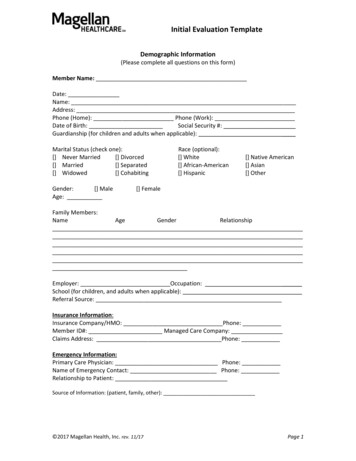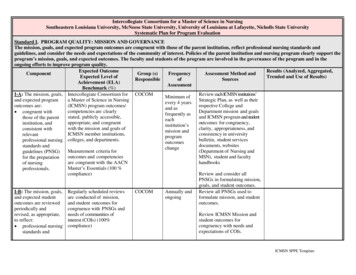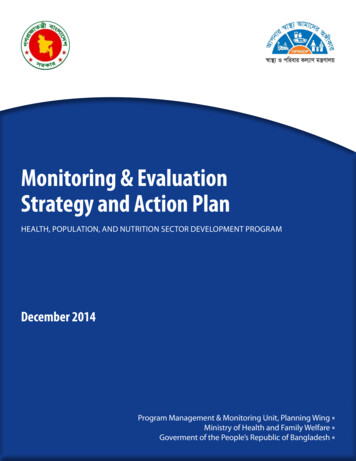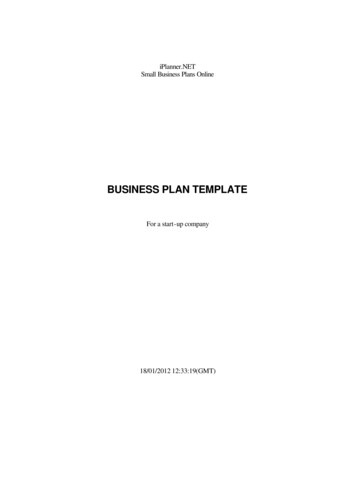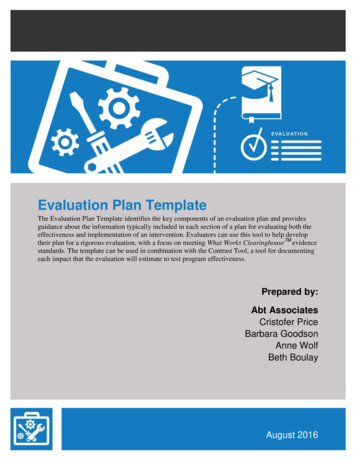
Transcription
Evaluation Plan TemplateThe Evaluation Plan Template identifies the key components of an evaluation plan and providesguidance about the information typically included in each section of a plan for evaluating both theeffectiveness and implementation of an intervention. Evaluators can use this tool to help developtheir plan for a rigorous evaluation, with a focus on meeting What Works ClearinghouseTM evidencestandards. The template can be used in combination with the Contrast Tool, a tool for documentingeach impact that the evaluation will estimate to test program effectiveness.Prepared by:Abt AssociatesCristofer PriceBarbara GoodsonAnne WolfBeth BoulayAugust 2016
The Institute of Education Sciences (IES) has made this tool publicly available as acourtesy to evaluators. However, the content of this tool does not necessarily representIES’s views about best practices in scientific investigation.This tool was developed under U.S. Department of Education Institute of Education Sciences(IES) contracts ED-IES-10-C-0064 with Abt Associates and ED-ODS-12-A-0019/0031withAEM Corporation and its subcontractor Abt Associates. These contracts provided evaluationtechnical assistance for evaluations of interventions funded by the Investing in Innovation andFirst in the World programs. Tools, webinars, and other materials were developed to helpgrantees engage in good scientific practice and produce evaluations that meet What WorksClearinghouseTM evidence standards.
CONTENTSGrantee/Project Name:1. Evaluator Information . 11.1 Contact Information . . 11.2 Independence . . 11.3 Confidentiality Protections . . 12. Summary of Intervention(s) . 23. Impact/Effectiveness Evaluation . 23.1 Research Questions . . 23.2 Comparison Condition . . 33.3 Study Sample and How Intervention and Comparison Groups areSelected/Assigned . . 43.4 Key Measures and Plan for Obtaining Data . . 63.5 Statistical Analysis of Impacts . . 73.6 Attrition (RCTs Only) . . 73.7 Baseline Equivalence Testing (QEDs and RCTs with High Attrition) . . 83.8 Implementation Evaluation . . 83.9 Logic Model for the Intervention(s) . . 93.10 Research Questions for Implementation Evaluation . 103.11 Data Collection Plan and Key Measures . 103.12 Analysis Approach . 103.13 Other Investigations . 114. References . 11EVALUATION PLAN TEMPLATEi
WHAT TO INCLUDE IN EACH SECTIONThe Evaluation Plan Template provides guidance about the details typically included in each sectionof a plan for evaluating the effects of an intervention. The guidance appears in italics in a box undereach section heading. Throughout, there are references to additional resources or tools that areavailable to assist you as you develop your evaluation plan, including the U.S. Department ofEducation’s What Works ClearinghouseTM Procedures and Standards Handbook, Version 3.0.You can use this document as a template for your evaluation plan by adding your text below theguidance box. After adding your text, you can delete the guidance box. After editing, update thetable of contents, so headings and page numbers remain accurate.There are some priority sections that should be completed as part of initial evaluation planning. Thepriority sections are: Evaluator information; Summary of intervention(s); Impact/Effectiveness evaluation, specifically the subsections on research questions, comparison condition, study sample and how intervention and comparison groups are selected/assigned, key measures and plan for obtaining data; andImplementation evaluation, specifically the subsections on logic model, and research questions.The remaining sections, which address your analytic approach, are not as urgent at the beginning ofan evaluation and can be completed later in the process. These remaining sections are: Subsections of the Impact/Effectiveness evaluation section statistical analysis of models, attrition, and baseline equivalence testing;Subsections of the Implementation evaluation section data collection plan and key measures, and analysis approach; andOther investigations.EVALUATION PLAN TEMPLATEii
EVALUATION PLAN TEMPLATE1. Evaluator Information1.1Contact InformationList the name and address of the organization or person conducting the independent evaluation.Also include the name, phone number and email information for the primary contact person(s)responsible for carrying out the evaluation for reference.[Text can be added here.]1.2IndependenceFor some, the organization or person conducting the evaluation must be independent of andexternal to the entity implementing the intervention and any partners. To be considered anindependent and external evaluation: (a) findings reported should not be subject to the approval ofthe project director or staff conceptualizing/implementing the intervention; (b) the evaluator shouldindependently conduct all key aspects of the evaluation, including random assignment, collectionof key outcomes data (other than from administrative records), analyses, and reporting of studyfindings.[Text can be added here.]1.3Confidentiality ProtectionsIndicate whether the study has secured relevant Institutional Review Board (IRB) approvals.Describe the plans for protecting confidential data.[Text can be added here.]EVALUATION PLAN TEMPLATE1
EVALUATION PLAN TEMPLATE2. Summary of Intervention(s)This section would typically be a few paragraphs that include the following: Objectives of the intervention (what key outcomes are expected to be affected), Activities and services that will be newly introduced or expanded and are intended to achievethose objectives, Target population eligible to receive intervention services (e.g., schools serving disadvantagedstudents; transfer students; low-achieving students), and Intended duration of the intervention.Make sure to specify how the intervention services work together to achieve the intended changein outcomes for the targeted set of students or faculty. Describe specifically what is given to theintervention group that is not available to the comparison group.[Text can be added here.]3. Impact/Effectiveness EvaluationNote that if the evaluation will include more than one impact study design (e.g., a student-levelRCT testing the impact of one component of the intervention and a QED comparing interventionand comparison schools), it’s helpful to repeat sections 3.1 through 3.7 below for each design.3.1Research QuestionsThe research questions would typically include the following: The name of the intervention (or, if there is no formal name, the intervention or combination ofcomponents), The comparison condition, (see definitions below), The outcome expected to be affected, and The educational level of the student sample (if relevant).For example, a research question that includes all of this information might read as follows: “Whatis the effect of the STEM Academy on college freshmen’s persistence and ultimate completioncompared to the business-as-usual condition?” Or, another example: “Does providing potentialtransfer students with access to formal supports (including X, Y, and Z) compared to providing noformal supports increase their rates of college completion?”[Text can be added here.]EVALUATION PLAN TEMPLATE2
EVALUATION PLAN TEMPLATE3.2Comparison ConditionAlthough you’ve already named the comparison condition in the previous section, this section caninclude a more complete description of the condition that the intervention is being compared to. Itis helpful to describe the likely instruction, services, or experience of students in the comparisoncondition, and how they differ from those in the intervention.Note that study designs that have the potential to meet What Works Clearinghouse Standards(with or without reservations) can have a comparison group that may receive any of the following:1. An alternative intervention (e.g., an existing tutoring program, when the intervention beingevaluated is a new one)2. “Business-as-usual”(whatever would ordinarily be available to the group targeted for theintervention)3. No treatment at all (when the intervention represents a totally new type of service oractivity)Evaluations that compare different amounts of exposure to an intervention (e.g., studies of dosageor moderator effects) are not eligible under the WWC standards. Such investigations, which donot examine intervention impacts, can be described in section 5, “Other Investigations”.This difference between the comparison condition and the intervention, also called the “contrast,”will be important for determining whether your evaluation has a sufficient sample size and how tointerpret the impacts estimated. Typically, smaller differences require larger sample sizes.[Text can be added here.]EVALUATION PLAN TEMPLATE3
EVALUATION PLAN TEMPLATE3.3Study Sample and How Intervention and Comparison Groups areSelected/AssignedThe description of how the intervention and comparison groups are formed typically includes thefollowing information:Sample: Identification of units eligible for participation (e.g., schools with low graduation rates;students who need developmental education)o Inclusion/exclusion criteria (e.g., grade level, test scores, demographics, major)Unit at which groups are to be selected/assigned (e.g., school, faculty/class, student)Target sample size at each levelExtent to which the sample represents the full population and settings being served by theintervention (e.g., sites, grade levels, demographic characteristics).Selection/Assignment: Method of assignment (e.g., random assignment, matching or other non-random approach)Timing of when intervention and comparison groups are to be selected/assignedProcedure for selecting/assigning groups (e.g., grouping eligible units on some commondimensions and then randomly assigning within those groups (“blocking” or “stratification”);characteristics used for matching)Procedures for tracking units after selection/assignment and ensuring intervention deliveryto correct group (e.g., monitoring “cross-overs” (comparison group members whoinadvertently participate in the intervention) and “no-shows” (intervention group memberswho do not wind up participating in the intervention offered/available to them)).Multi-semester/year and multiple cohort studies: For multi-semester interventions (where the intervention is intended to be provided to thesample for more than one semester) and multiple-cohort studies (where multiple samplesreceive the intervention in different years), how the sample will be followed over time,including:o Length of intervention when outcomes are measured (e.g., after the interventionhas been in place for one year, two years, and three years)o Grades/school year when outcomes measured (e.g., grade 12, freshman year)o Length of exposure for units measured at outcome (e.g., students who haveparticipated in the intervention for two years)o Number of cohorts that will be included in the sample (e.g., college freshmen fromfall 2015, fall 2016, and fall 2017)o Whether students will join the sample after the intervention and comparison groupshave been assigned*.EVALUATION PLAN TEMPLATE4
EVALUATION PLAN TEMPLATEIf cluster-level selection/assignment: If groups are to be selected/assigned at the cluster level (e.g., school districts, schools,faculty, classes), criteria and procedures for identifying/selecting units within the cluster(e.g., all students in all developmental education classes will be included in the sample;students from one class section for each instructor will be included in the sample; a randomsample of 10 students from each class will be included in the sample).o Inclusion/exclusion criteria*A note about sample selection and assignment, specific to cluster randomized designs: Incluster random assignment designs (e.g., schools randomly assigned to intervention and controlconditions), it is important to determine whether the lower level units (e.g., students or teachers inthe randomized schools) joined the randomized clusters after randomization. The WWC has avery strict approach to defining “joiners” for cluster randomized designs. In short, unless themembership of clusters is clearly defined and determined prior to randomization, then the WWCassumes that the cluster includes joiners. For example, if schools are randomized in the summer,and school enrollment is determined in the fall, the WWC assumes that students may have joinedthe clusters (schools) after random assignment. When schools are randomized, the WWC definesthe sample as not including joiners only if the analysis sample is limited to students who weredemonstrably enrolled in the schools prior to random assignment. Therefore, it is critical for clusterrandomized designs to be as clear as possible regarding the timing of when cluster membership isdetermined relative to the timing of the randomization of clusters. For example, can it bedemonstrated that all students in the analysis sample were enrolled in schools prior to schoolrandomization (or in classes prior to class or teacher randomization)?[Text can be added here.]EVALUATION PLAN TEMPLATE5
EVALUATION PLAN TEMPLATE3.4Key Measures and Plan for Obtaining DataThe plan for obtaining data would typically include the following: Time period(s) the data will represent (e.g., spring 2016 and spring 2017 for cumulativecredits earned)Plans for transfer of administrative data or primary data collection, if applicable (e.g., spring2016 credits earned will be obtained from school records during July-Aug 2016; a freshmensurvey will be administered in fall 2016)Plans to ensure the quality and consistency of data (e.g., strategies for common coding ofrecords from multiple schools; procedures for training data collectors, such as thoseadministering assessments or surveys; procedures for consistency across data collectors,such as those coding responses or observations)For each outcome measure and baseline measure*o Name and/or description of measure (e.g., instrument and subtest; number ofcredits accumulated; graduation rate; SAT/ACT score)o Domain being measured (e.g., math achievement, persistence)o Unit of measurement (e.g., school, teacher, class, student)o How variables will be constructed for analysis (e.g., summing/averaging surveyitems; creating a composite measure; calculating z-scores)o Information about reliability and face validityo Indication of the baseline measure(s) that corresponds to each outcome (or if thereis no corresponding baseline measure for a given outcome)Other student, teacher, and/or school characteristics that will be included in impact analysismodels as covariates or control variables.*Note that the WWC Postsecondary Education Review Protocol(http://ies.ed.gov/ncee/wwc/pdf/reference resources/wwc pe protocol v3.1.pdf)and the WWC Developmental Education Review Protocol(http://ies.ed.gov/ncee/wwc/pdf/reference resources/wwc de protocol v3.1.pdf) acknowledgethat pretest measures of the outcome are often unavailable or not relevant, in which case baselineequivalence for QEDs and RCTs with high attrition (see p.5-6 in each protocol) must bedemonstrated in two domains: a continuously-scaled measure of academic achievement (e.g.,high school grade point average, SAT/ACT scores) and a measure of student socio-economicstatus (e.g., FAFSA expected family contribution, family income, free- or reduced-price lunchstatus, parent education levels, Pell Grant eligibility).[Text can be added here.]EVALUATION PLAN TEMPLATE6
EVALUATION PLAN TEMPLATE3.5Statistical Analysis of ImpactsThe description of the analytic approach, typically includes the following: For each impact that will be estimatedo A very brief description of the intervention sample and comparison sample (e.g.,transfer students that participate in the CollegeConnect support servicesintervention compared to transfer students that participate in the business-as-usualsupport services)o Outcome domain, outcome measure, and unit of observation (e.g., school, teacher,class, student)o Timing of outcome measurement (i.e., duration of intervention or exposure)o Measures to be used to establish baseline equivalence (remember to check themost relevant WWC topic protocol, which lists the measures expected to be used)o Unit of observation for baseline measure(s) (e.g., student, teacher, class, school)o Timing of baseline measurement (e.g., how long before the intervention was offeredor began)Specification of the statistical model used to estimate the impact of the interventionApproach to handling missing data (for outcomes, baseline variables, and other covariates)Strategy for dealing with multiple comparisons (i.e., adjusting the threshold for statisticalsignificance for multiple tests with the same outcome domain)Subgroups for which the study plans to estimate intervention impacts, if applicableFor RCTs, plans for handling crossovers and no-showsThe estimated minimum detectable effect size, based on the design, planned sample size,and stated assumptions about other relevant factors affecting power (e.g., ICC, R-square)[Text can be added here.]3.6Attrition (RCTs Only)Attrition occurs when eligible units (schools, teachers, students) are randomly assigned but, forwhatever reasons, data cannot be collected from them. Significant amounts of attrition from eitherthe intervention or comparison/control group or both groups can compromise the initialcomparability of the groups resulting from random assignment and potentially lead to biasedestimates of the intervention’s impact.For RCTs, this section should describe the strategies that will be used to minimize attrition (school,teacher, student) from the sample. Specifically, the plan should address efforts to maximize thenumber of units in the sample used to analyze impacts (i.e., those with outcome data).In addition to describing strategies for minimizing attrition, it is also typical to describe the plan forcalculating attrition (i.e., the difference between the number of units assigned and the number ofunits in the analytic sample – for the sample overall and for each condition separately). For RCTsin which students
First in the World programs. Tools, webinars, and other materials were developed to help . available to assist you as you develop your evaluation plan, including the U.S. Department of Education’s What Works Clearin

